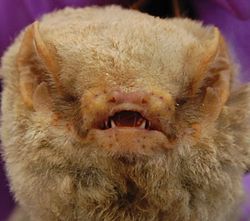| Glauconycteris | |
|---|---|
 | |
| Abo bat (Glauconycteris poensis) | |
| Scientific classification | |
| Kingdom: | Animalia |
| Phylum: | Chordata |
| Class: | Mammalia |
| Order: | Chiroptera |
| Family: | Vespertilionidae |
| Tribe: | Eptesicini |
| Genus: | Glauconycteris Dobson, 1875 |
| Type species | |
| Kerivoula poensis Gray, 1842 | |
| Species | |
See text | |
Glauconycteris is a genus of vespertilionid bats found in Africa. [1] [2]